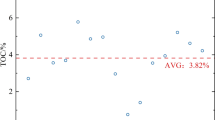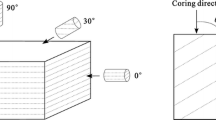Compressibility is a key parameter in shale volumetric fracturing design and effect evaluation, which reflects the ability of shale oil reservoirs to be pressed open and form complex network fractures of a certain scale under existing technology conditions. Existing compressibility index evaluation methods are mainly based on static data such as experimental data or logging evaluation, and the influencing factors of compressibility are different, resulting in unsatisfactory evaluation results. In order to solve the shortcoming of using brittleness index only to evaluate shale reservoir compressibility, this paper not only considers the influence of fracture toughness on compressibility, but also introduces another influencing parameter – critical mechanical energy release rate. The effect of type I fracture toughness on shale joint and fracture development and the average critical mechanical energy release rate during shale reservoir sliding are studied. Finally, combined with the sliding average critical mechanical energy release rate and brittleness index, a primary model of shale reservoir compressibility evaluation based on fracture development index is established. This method can provide ideas for accurately evaluating the compressibility of deep shale reservoirs.



Similar content being viewed by others
References
Chong K K., Urieser W V., Passman A. A completions guide book to shale play stimulation in the last two decades. SPE 133874, 2010.
Jiang Tingxue, Bian Xiaobing, Su Yuan et al. A new method for evaluating shale fracability index and its application [J]. Petroleum Drilling Techniques.2014, 42(5):16-20.
Fang C., Amro M. Influence Factors of Fracability in Nonmarine Shale. SPE 167803, 2014..
Atefeh J., Behnam J. Optimization of hydraulic fracturing design u der spatially variable shale fracability. SPE 169521, 2014.
Mu Jingfu. Anisotropic Investigation of the Mechanical Property of Shale [J]. Unconventional Oil &Gas, 2016, 3(5):114-120.
Rickman Rmullen M. J., Petre J.E. et al. A practical use of shale petrophysics for stimulation design optimization: AIl shale plays are not clones of the Barnett shale [R]. SPE 1152582008.
Bruner K.R. SMOSNARA comparative study of the Mississippian Barnett shale, Fort Worth basin, and Devonian Marcells shale, Appalachian basin [R. US. Department Energy, National Energy Technology Laboratory, 2011,106.
Yuan Junliang, Deng Jingen, Zhang Dingyu et al. Evaluation technology of fracturing ability of shale gas reservoir [J]. Journal of petroleum, 2013, 34(3):523-527.
Xin Cuiping, Bai Huifang, Zhang Lei et al. Application study of multistage fracturing horizontal well production forecasting models for shale gas with different fracture forms. Unconventional Oil &Gas, 2020, 7(3):65-71.
Mu Jingfu, Gao Zhiliang, Zhang Li et al. Experimental study of the effect of water and liquid CO, fracturing on shale fracture morphology. Unconventional Oil &Gas, 2021, 8(5):87-92.
Luo Pan, Zhang Lei, Zhong Yajun et al. SRV optimization for volumetric fracturing of continental shale in Yanchang Oilfield. Unconventional Oil &Gas, 2022, 9(4):129-133.
Yang L., Ge H., Shi X. et al. The effect of microstructure and rock mineralogy on water imbibition characteristics in tight reservoirs. Journal of Natural Gas and Science and Engineering. 2016, 34:1461-1471.
Guo Zhiqi, Li Xiangyang, Liu Cai et al. A shale rock physics model for analysis of brittleness index, mineralogy and porosity in the Barnett shale Journal of Geophysics Engineering. 2013, 10(2):25006-25015
Liu Z., Sun S., Sun Y. et al. Formation evaluation and rock physics analysis for shale gas reservoir. A case study from south China[C]. EAGE Annual Meeting Expanded Abstracts. Houten, The Netherlands: EAGE 2013.
Chen Jianguo, Deng Jingen, Yuan Junliang, et al. Determination of fracture toughness of modes I and II of shale formation [J]. Chinese Journal of Rock Mechanics and Engineering, 2015, 34(6):1101–1105.
Griffith A.A. The phenomena of rupture and flow in solids [J]. Philosophical Transactions of the Royal Society of London,1920, A221:163–198.
Irwin G. R., Kies J.A., Smith H.L. Fracture strengths relative to onset and arrest of crack propagational Proceedings American Society of Testing Materials, 1958, 58(58):640-657.
Deng Jingen. Wellbore stability prediction technology [M]. Beijing: Petroleum Industry Press, 2008:56–62.
Du Hongshan, Jia Zhang. Statistic inspection and mathematical treatment of experimental data [J]. Atomic Energy Science and Technology, 1987(4):397–404.
Author information
Authors and Affiliations
Corresponding author
Additional information
Translated from Khimiya i Tekhnologiya Topliv i Masel, No. 5, pp. 124–128 September–October, 2022.
Rights and permissions
Springer Nature or its licensor (e.g. a society or other partner) holds exclusive rights to this article under a publishing agreement with the author(s) or other rightsholder(s); author self-archiving of the accepted manuscript version of this article is solely governed by the terms of such publishing agreement and applicable law.
About this article
Cite this article
Mu, J., Qiao, H. & Guo, Q. A Fracture Toughness-Based Evaluation Method for Deep Shale Oil Reservoir Compressibility. Chem Technol Fuels Oils 58, 880–886 (2022). https://doi.org/10.1007/s10553-022-01463-8
Published:
Issue Date:
DOI: https://doi.org/10.1007/s10553-022-01463-8




